In cities throughout the United States on Saturday, protesters flooded streets in a national rally against the Republican administration of US President Donald Trump. The total headcount is difficult to determine: while exact numbers were still being calculated at the end of the weekend, it was initially estimated Saturday evening that between 4-6 million people attended over 2,100 demonstrations across the country, meaning nearly 2 in every 100 Americans were on the streets on Saturday afternoon.
Springfield was no exception: state officials estimated 1,000 people were present at the state capitol complex with hundreds more lining the streets between Capitol Avenue and Old State Capitol Plaza. They marched through downtown, chanting various slogans calling for the removal of Trump, for an end to ICE raids, for the termination of military operations in American cities, and more.
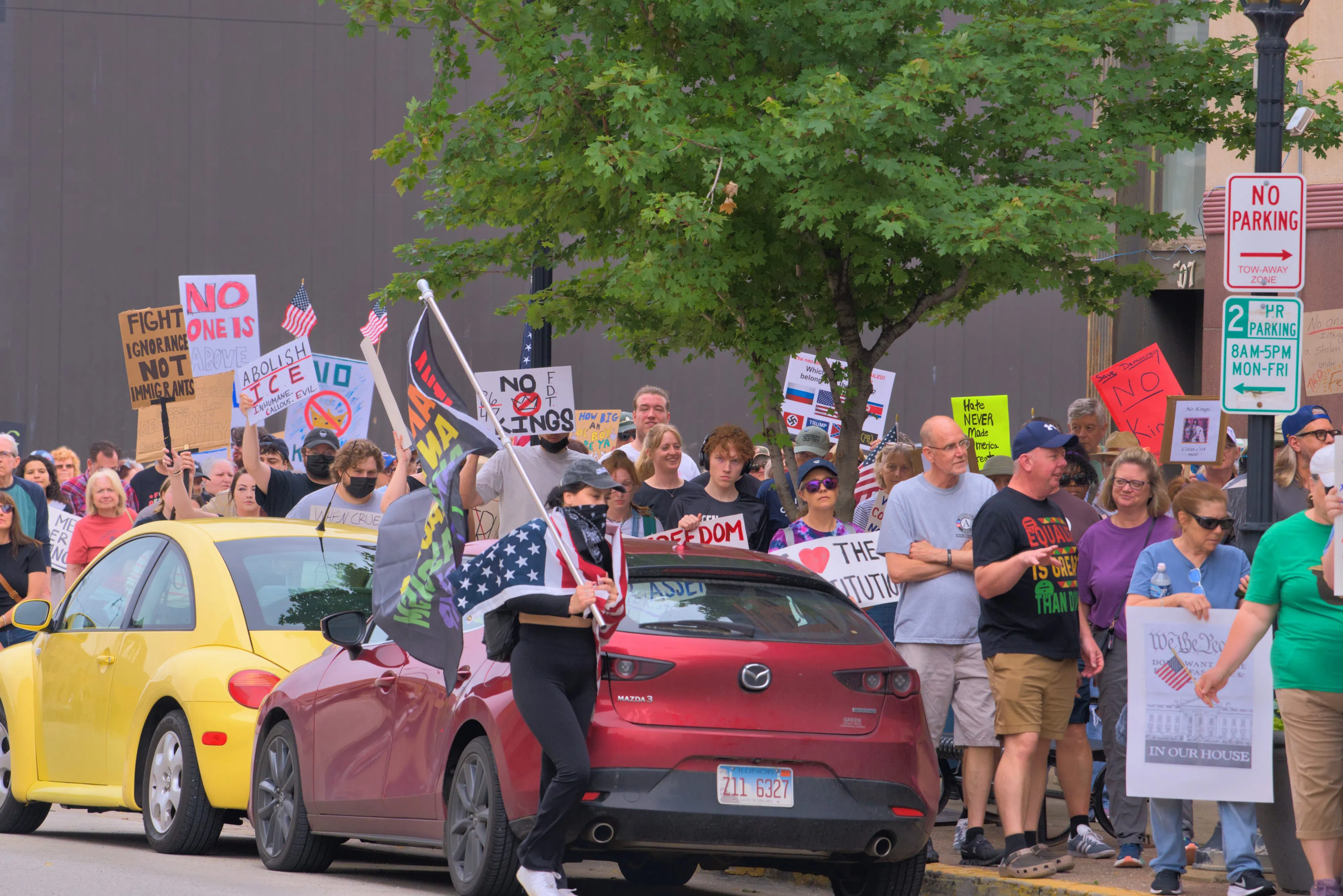
A protestor draped in US colors waves an anti-fascist pride flag as No Kings protesters wait to cross the street, June 14, 2025 (WMAY News, photo cred. Stan Anders)
The protests in Springfield were calm. No police intervention was necessary throughout Saturday, even when a convoy of honking SUVs bedecked in MAGA flags and signage attempted to disrupt marchers traveling along crosswalks, only to speed off along 4th Street and repeatedly circle back around and again to interfere with pedestrian traffic.
Similar protests took place throughout Illinois, including in Rockford, Carlinville, Galesburg, and Chicago. In Chicago, the number of marchers was counted at 75,000.
In other places throughout the United States the total reached even higher: 80,000 people are claimed to have attended the demonstration in St. Paul, Minnesota, despite MN Governor Tim Walz requesting people remain home due to an active shooter risk from an assassin impersonating law enforcement, with two Democrat state lawmakers shot and many more targeted. In Philadelphia, the count came to 80,000-100,000. Between 50,000 and 200,000 are estimated to have been in and around New York City’s Bryant Park. The conservative New York Post claimed the low end estimate of 50,000, while other sources leaned closer to a count of over 200,000 claimed by organizers.
In Los Angeles, despite crackdowns against ongoing anti-ICE protests, at least 200,000 people rallied outside LA City Hall. Late in the afternoon, LAPD and LASD insisted they had perceived “agitators” in the crowd, suddenly prompting police to suppress protesters after the order went out for rally goers to disperse. Despite the Sheriff describing rocks and bottles being thrown at riot police and mounted officers being attacked, only a lone Sheriff’s Deputy was reported injured in the apparent violence.

(WMAY News, photo cred. Stan Anders)
The residents of Springfield and Central Illinois who participated in Saturday’s events helped contribute to what is now being called by some the largest single-day, nationwide anti-government protest in US history: for comparison, on June 6 2020, the peak day of the George Floyd protests, over 500,000 were believed to have attended. Over time, however, that series of protests eventually drew a total of up to 26 million people, nearly 1/10 of the US population, eclipsing all other protests to date.
As of publication, event organizers of the 50501 Movement claimed the count was vastly higher, breaching 12 million participants.
The Republican administration made haste to mock the protests, with White House Communications Director taking to Twitter mid-Saturday to call them “a complete and utter failure with minuscule attendance.”
The so-called No Kings protests have been a complete and utter failure with minuscule attendance. It is sad Democrats and liberals would rather support criminals and illegals instead of celebrating the 250th anniversary of our great U.S. Army and Flag Day. But many more Americans…
— Steven Cheung (@StevenCheung47) June 14, 2025
The government has been eager to downplay the protests as they coincided with a rare military parade in DC, ostensibly designed to celebrate the 250th birthday of organized US army troops. Critics of the parade, however, drew attention to the fact that US Armed Forces share a birthday with President Donald Trump, who has been eager for a military spectacle ever since being wowed by the 2018 Bastille Day parade in France.
Social media was unkind to the Army’s birthday parade however, with posters across platforms mocking seemingly anemic crowd sizes in the National Mall, half-empty bleachers and strange choreography for the procession of 6,000 soldiers in period gear and historical armored vehicles.
I did not edit this, this is the actual parade with the actual music being played.
CINEMATIC
— Timothy Burke (@bubbaprog.lol) June 14, 2025 at 6:32 PM
The photos coming from Trump’s birthday parade are just incredible. No one showed up.
— Matt McDermott (@mattmfm.bsky.social) June 14, 2025 at 5:56 PM
Soldiers march past empty stands at Trump’s parade.
— Molly Ploofkins (@mollyploofkins.bsky.social) June 14, 2025 at 9:08 PM
Sound engineers pointing out in the comments that the applause is from an indoor audience on an outdoor event💀
— LorennaCleary.bsky.social (@lorennacleary.bsky.social) June 15, 2025 at 9:37 PM
The silent crowd with the squeaking has me CRYING pic.twitter.com/3QhHnAyXVw
— B.W. Carlin (@BaileyCarlin) June 14, 2025
The White House now claims that attendance substantially exceeded an anticipated 200,000 persons. Other estimates have been less optimistic. Yet the government continues to challenge the narrative that more people were preoccupied with protesting than with celebrating the army, which has been the subject of hot criticism over the recent deployment of over 700 federal soldiers and thousands more national guard to Los Angeles, California; a city Republicans insisted required liberating from rebels, foreign invaders, and its own elected officials.
In “Lawless” Los Angeles, Angelenos see lawlessness in the fed
In the lead-up to Saturday’s parade in DC, federal officials threatened action against demonstrators, with Trump promising “very big force” for anyone protesting the event itself. In keeping with rhetoric from the president and his advisers, federal government officials have insinuated protests are being conducted to overthrow the rule of law. Protesters, however, argue they are protesting the death of the rule of the law.
Over the past week, a wide variety of claims were made by the White House that protests in the Californian metropolis of Los Angeles had escalated to open rebellion. Last Friday, in a series of highly controversial moves immediately challenged in court, first the California National Guard was federalized and deployed into the city and then the US Marines were also deployed, with the Secretary of Defense declaring US Armed Forces would be present to protect and enhance federal Immigration and Customs Enforcement agents deployed to help meet a reported quota of 3,000 immigrants per day.
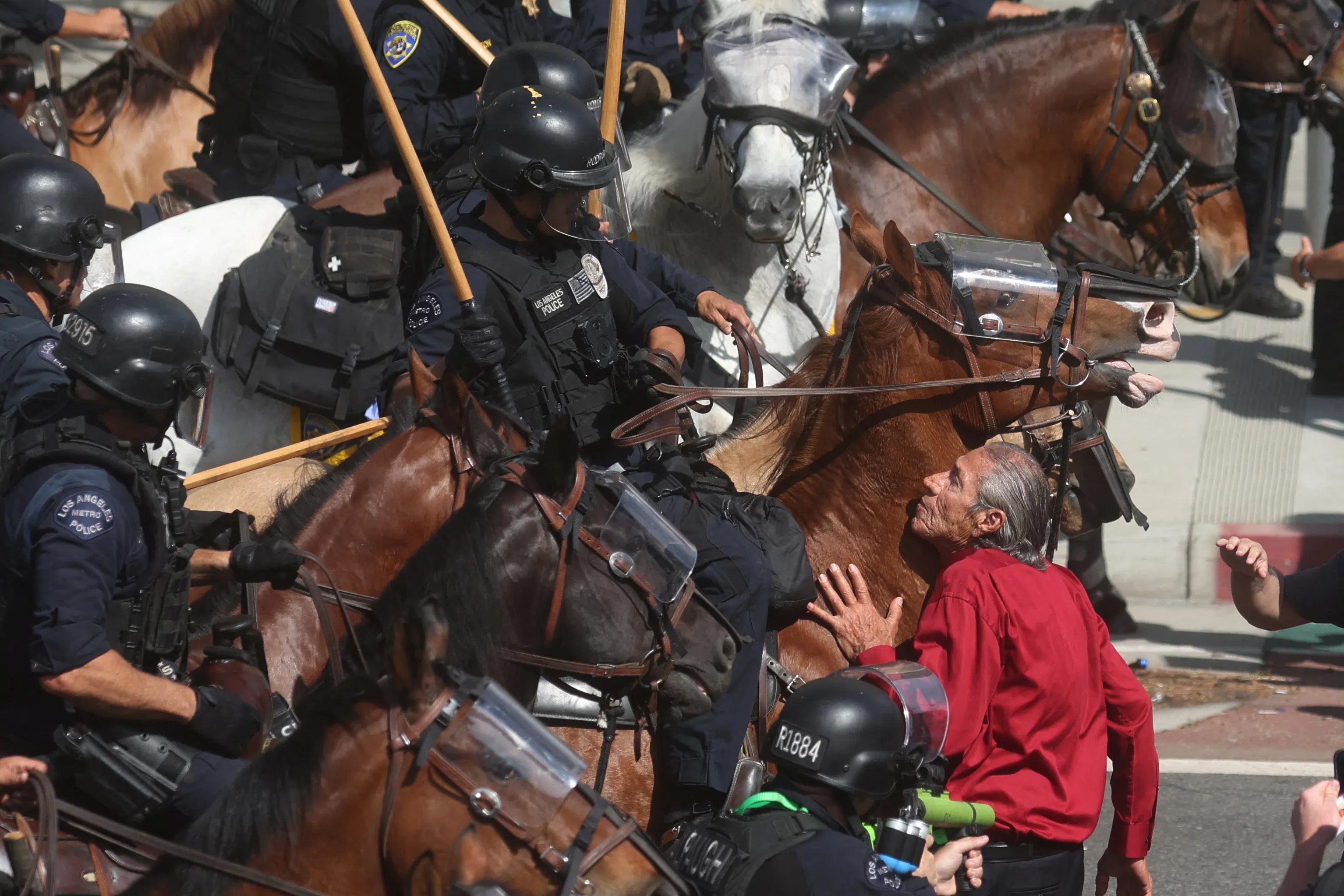
A demonstrator blocks mounted police officers during a “No Kings” protest against U.S. President Donald Trump’s policies and federal immigration sweeps, in Los Angeles, California, U.S., June 14, 2025. REUTERS/Pilar Olivares
“A once great American City, Los Angeles, has been invaded and occupied by Illegal Aliens and Criminals,” the president wrote on his social media. “But these lawless riots only strengthen our resolve.”
Lawlessness was a critical element of the administration’s description of events unfolding as Los Angeles residents rallied against DHS. Secretary of Defense Pete Hegseth has insisted troops were necessary to restore “Law and Order” to the city. Section 12406 of US Code Title 10 requires rebellion or threat thereof for federalization of national guard troops, to say nothing of the federal armed forces. The federal government’s characterization, legal analysts have stated, is the strategy by which the White House’s desire to send the military into a US city is justified.
Yet on the ground, protests in Los Angeles have been far from riotous. WMAY received an extensive description of the condition in LA from one longtime resident: Felipe Cabello is a naturalized US citizen, having passed the naturalization test in 2009 while in high school. Born to parents of means in Santiago, the capital of the South American Republic of Chile, he was 5 years old when he immigrated with his family in 1997. He has lived in the US ever since. Felipe has a background in law with a focus on foreign policy, and even after his naturalization has remained well-read on evolving domestic immigration rules, in part as an extension of work he did on behalf of the United States policymakers covering human trafficking; an issue very closely related to the immigration debate.
Cabello observed that the extent of lawlessness in Los Angeles is such that street vendors have felt safe to set up shop amid protesters, selling street food, produce, drinks and merchandise to people the government has taken pains to describe as violent rioters.
“Even vehicles can drive on by through the crowds,” he said. “People aren’t against each other. They’re against a very specific set of folks who are disrupting the community.”
Those “folks,” says Cabello, are the Department of Homeland Security: “This very much is seen as a concerning invasion… To also throw in, ‘We’re here to liberate you from locally elected leadership…’ what is this liberation that we are talking about? When you have troops on the street, ‘Liberation of Iraq’ can kind of come to mind. Is that what we’re talking about?”
Although demonstrations have expanded to various parts of the city, protests in LA have been focused on a specific federal complex in downtown LA: “It’s being used as the detention center for this particular operation,” explained Cabello. “It’s where the vans arrive, and therefore it’s where people are protesting, where they try to get in front of these vehicles to stop that from happening.”
Misconceptions surrounding the nature of immigration, as well as immigration enforcement, persist in popular culture, warns Felipe. The lexicon of American politics has evolved extensively over the last several decades: the contentious term “illegal immigrant,” or the pejorative “illegals” previously fell into disfavor for government use as opposed to the more cumbersome “undocumented immigrant,” because “illegal” has the potential to mislead the layperson.
While not untrue by the definition of “illegal” understood by lawyers, in common parlance “illegal” carries a connotation of “criminal.” Contrary to popular belief, unapproved physical presence in the United States is not, on its own, a crime. Civil liability, not criminality, ensues from improper immigration status, the primary outcome of which is almost guaranteed to be deportation. The Supreme Court has clarified for over a century that deportation is not a criminal punishment. However unlawful entry, meaning entry without proper inspection at a designated port of entry is a misdemeanor. Unlawful reentry after a deportation is classified as a felony crime. Neither of these crimes automatically apply to a person who has overstayed a visa, who entered the country legally, but either willfully or accidentally remained past the designated time limit.
Immigrants, legal or otherwise, generally engage with a parallel, quasi-judicial review system known as immigration court. These offices are administrated by the US Department of Justice rather than the judiciary, and their “immigration judges” are in fact a form of special officer of the DOJ. Their authority to review and dispense relief in cases of immigration status stems from the authority of the US Attorney General to do so, as provided under the law. They cannot convict an individual of a crime; their primary function is to decide removal cases and order deportations.
No serious reading of the constitution exists in which immigrants are not subject to the law of the United States. The Constitution carefully indicates a distinction between mere “persons” and “Citizens.” For non-citizens to be liable for criminal conduct, it is necessary for them to be expected to uphold the law during their time in the United States. Therefore, non-citizens have always been understood to enjoy all rights not explicitly limited to citizens under the Constitution — including the right to due process under the law.
“When people are unlawfully — and this is no longer my opinion, we have court opinions here,” said Cabello, “when people are unlawfully sent abroad without due process; when court decisions that are meant to correct unlawful practices from government are ignored; when DHS and its secretary say that they intend to continue in these practices — that’s to say, they know it’s unlawful and they don’t care… The illegality is in the mass-kidnappings that are going on at the hands of goons. This is illegal. This is the illegality.”

A demonstator holds a sign in front of police officers during protest against U.S. President Donald Trump’s policies and federal immigration sweeps during a No Kings Day demonstration in Los Angeles, California, U.S., June 14, 2025. REUTERS/David Ryder
Since the recent ramp-up ICE agents have been seen indiscriminately grabbing persons of interest as well as passersby; both employees at businesses as well as their employees — this, Felipe contends, is evidence they cannot possibly be doing so with probable cause.
“I’m not talking about people who are hiding away their criminal son, I’m not talking about people who are non-criminal offenders or people who overstayed a visa, or something,” he said. “There are people who have, perhaps, done everything correctly. Some of them have been arrested leaving the administrative court hearings to make sure they’re doing everything correctly. They’re doing what they’re being asked. Some of them actually have temporary protected status, and they get a text message – I think we’re up to a million people who’ve gotten a text message that says, ‘Actually, you’re not covered by this anymore, and also you have to leave now.’ That’s not due process, and that’s not a criminality.”
To put into context the problem posed by the federal government’s disregard for court instructions, Cabello raised the following hypothetical:
“If I were to see someone on the street getting snatched up by somebody else with no reason to think that it’s a lawful arrest, I would be compelled to do something about it. If I see a felony being committed, I am not just within my rights. Some might say that I have an obligation to stop that. Some states would actually say that if you see a felony being committed, you have the right to use lethal force.
“That’s what’s happening here: these are people who are being snatched up. These are felonies being committed against members of this community, and people are trying to stop it, because there’s nothing lawful about it. These are crimes that are being committed and wrapped around this veil of ‘Law and Order.’ That’s what this reaction is: it’s a reaction against unlawful, illegal seizure of people on our streets, people that are part of our community.”
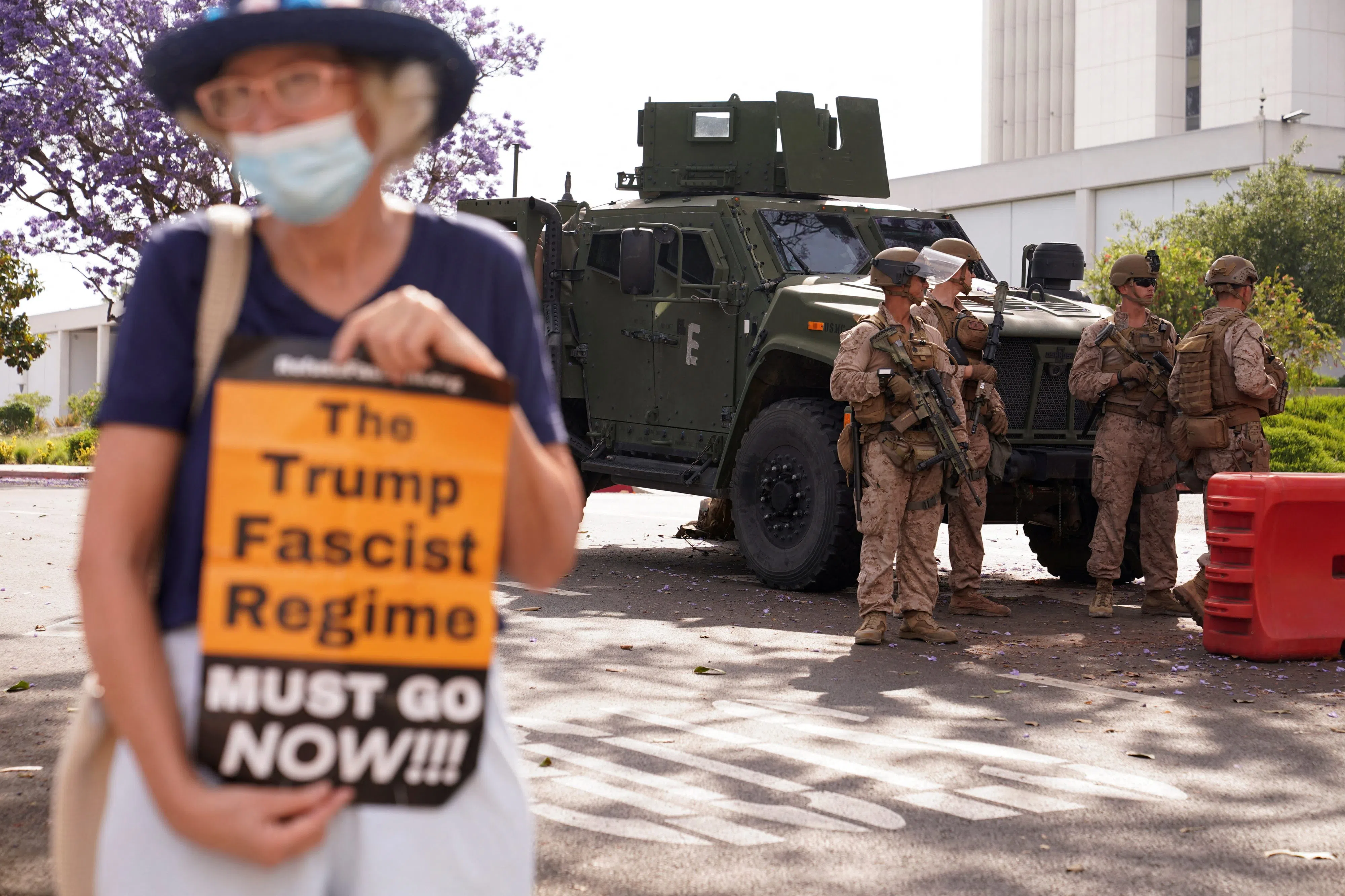
A woman holds a pamphlet as U.S. Marines stand guard outside the Wilshire Federal Building, after they were deployed to Los Angeles as federal immigration sweeps continue, in Los Angeles, California, U.S., June 13, 2025. REUTERS/David Ryder
Where many voices make many demands, one message stands out: “Put ICE on ice”
At this point, many of the highest profile gatherings in Los Angeles have largely dispersed. While the White House has seemingly yielded to pressure to slow down raids on workplaces for critical industries, the rhetoric from LA law enforcement seemingly suggests that the protesters are standing down and obeying citywide curfews.
Yet while demonstrators do remain out on the streets in reduced numbers, the protests have not gone without impact: in the neighboring LA County city of Glendale, city administrators terminated an 18-year-old contract with DHS permitting the department, and specifically ICE, to use city jails as holding facilities for detainees, with the city being compensated at a rate of $85 per person, per day. The agreement predated the California Values Act, a 2017 state law similar to the Illinois TRUST Act which limited statewide cooperation with immigration agents. Under the law, Glendale’s contract was permitted to remain in effect until terminated by either party.
City residents raised the issue to Glendale City Council on June 3, days before protests picked up momentum and days still before the federal government began threatening to deploy military units in response to the demonstrations. By Friday, the White House began claiming the right to nationalize California National Guard units, who were already deployed by the state government for emergency support of disaster recovery relating to the Palisades Fire in January.
On Sunday, June 8, with demonstrations in full swing and Trump administration appointees spreading claims of mass-rioting, open rebellion and foreign invaders in the streets of Los Angeles, the City of Glendale rescinded its contract with DHS, reducing ICE’s ability to locally store captives.
Demonstrators in Los Angeles most likely have a wide variety of intentions and goals with little cohesion. Many common calls to action and picket sign slogans at these events were for changes only actionable at the state or federal levels: abolish ICE, impeach the president, dismantle DHS, end military support for Israel, defund the police, refund national agencies — demands which protesters deem important to publicize, yet largely dismissed as irrelevant by cities.
Despite this, the City of Glendale’s decision presented activists with a tangible victory at a local level. In the months since the re-inauguration of Donald Trump, activists in municipalities across the country have sought to encourage their local governments to speak against the administration’s actions. A major target of this encouragement has been calls to forbid local law enforcement personnel from cooperating with federal immigration agents, effectively expanding the list of nationwide sanctuary cities.
The administration’s plan for ICE enforcement action depends heavily on cooperation of local law enforcement. Since the inauguration, hundreds of new cooperation agreements have been reached between the agency and local police forces throughout the US, empowering non-DHS officers to scrutinize immigration status of individuals encountered in daily police business. This deputizing of local LEOs who lack specialist training for handling immigration, combined with a quota-driven approach to immigration enforcement, has raised worries that officers may resort to racial profiling to find the numbers they need to meet the fed’s expectations.
Those worries, advocacy groups say, have already born out as the rapid expansion of ICE operations has already resulted in a battery of illegal seizures of US citizens.
The wave of misconduct by federal personnel has lead police departments to warn that Immigration & Customs is making daily police work harder and ratcheting up tensions between communities and their law enforcement.
Therefore, activists argue, a very reasonable response is to freeze cooperation agreements with ICE.
Where Springfield stands, the ground shifts
In Illinois, the TRUST Act effectively makes all cities and counties “sanctuary” locations for immigrants. Police in Illinois are forbidden by law from cooperating with federal agents in carrying out immigration enforcement actions under most circumstances. The law does stipulate that law enforcement may assist in immigration actions if a warrant is involved — critically, despite immigration courts issuing their own “immigration warrants,” the warrants dispensed by immigration judges are entirely distinct from judicial warrants and cannot on their own compel law enforcement to act. Nor do they give ICE agents legal access to a person’s place of dwelling.
Despite knowing this, ICE officials have been routinely found mischaracterizing their warrants to coax out permission to enter homes to be able to conduct arrests. In some cases, as in a recent incident in Tucson, Arizona, ICE personnel have posed as utility workers in order to deceive their targets.
Immigrants residing in Illinois of all forms of immigration status – deferred action, work visas, legal residence or otherwise – recently frustrated ICE personnel by successfully dismissing immigration warrants when asked to allow federal agents to enter their homes for inspection; leading the White House’s “border czar” Tom Homan to complain to CNN in the wake of the fed’s highly publicized failed raids in Chicago earlier this year that, “They’ve been educated how to defy ICE, how to hide from ICE.”
Whether they are in the United States legally or not, permanent residents or on work visas, immigrants have expressed abundant reasons to fortify behind these rights and avoid immigration agents: even excluding the claims of “disruption” reserved for immigrants who have spoken against the Israeli-Palestinian conflict, many people legally in the country have been seized during routine interactions with federal agencies.
One anonymous resident of Springfield, who has worked in the city for nearly a decade, confessed to WMAY that they are unsure they will proceed with the naturalization process: they cited the seizure of a Mississippi welder who was arrested and separated from his US-born wife and children while attending his appointed naturalization interview.
“I mean, that guy was white, wasn’t he,” they pointed out. “They just lost some of his paperwork and they put him away? What’s my chances? You tell me, how do you do this, legally?”
The situation has angered several residents of the city, who for months have been pressing Mayor Misty Buscher and the Springfield City Council to make some form of comment against the federal government’s behavior.
That anger was stoked last month by a strange, dramatic and brief visit to Springfield by Homeland Security Secretary Kristi Noem. Noem’s arrival at Abraham Lincoln Capital Airport heralded the seizure of two Springfield residents with Guatemalan passports, who ICE agents asserted were in the country illegally. Noem hastily dodged protesters outside her initial planned stop at the governor’s mansion and instead made remarks in front of the home of the late immigrant advocate Emma Shafer in defiance of her family’s wishes. The two people detained by ICE were later told directly by Noem in front of camera crews that they were being deported, while their American children sat abandoned to the city’s community.
Creating a situation in which children are left unattended, it was dimly noted at City Council the week after Noem’s excursion to Springfield, is a violation of state law.
In the wake of the Los Angeles protests, calls for action at the horseshoe have once again escalated:
“Helpless people are being dragged out of their homes and workplaces, families are being torn apart, and children are coming home to their families being gone,” Breonna “Bree” Roberts said to the June 10 Springfield Committee of the Whole, days after the fed established a military presence in Los Angeles. “Citizens are being shot with rubber bullets and arrested for exercising their rights to protest — and it’s only been six months… It feels like this city has done nothing to take precautionary measures, to make sure what is happening in LA has no chance of happening here.
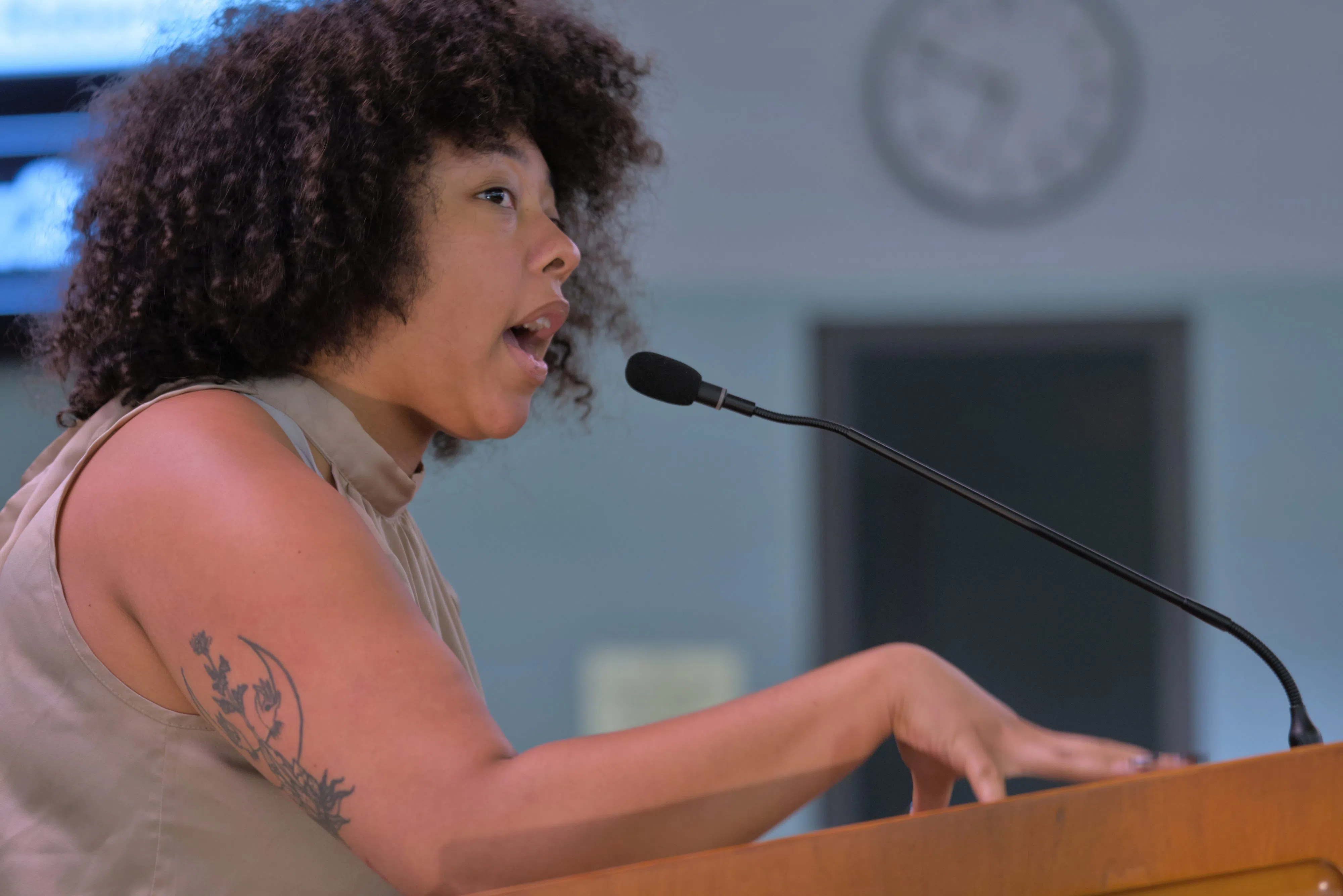
Breonna Roberts speaks to Springfield City Council, June 10, 2025 (WMAY News, Photo cred. Stan Anders)
“It might seem like a stretch,” Bree conceded. “It might seem like, ‘Well that would never happen in Springfield…’ until it does. And to some, this is just the way it’s supposed to be, and people get away with turning a blind eye because it would never happen to them, it would never happen to their family. And if it doesn’t affect some people, they don’t care. But we don’t have the luxury of waiting until it personally affects us anymore.”
She continued, “Silence is the breeding ground for white nationalism. And when we do get loud, our protests are met with military deployment, tear gas and rubber bullets… if it can happen in LA, it can happen in Springfield. As a resident of this town, I need to know that my mayor will do whatever it takes to protect her citizens. Please, if you are not already, please begin having conversations about what you have the power to do, to protect us.”
That same night, retired service member and veteran of the Iraq War Aaron Cahill urged the Committee of the Whole to introduce ordinance language to further bar SPD and city services from interacting with federal immigration enforcement, declaring, “Springfield has always prided itself on being a welcoming city… a city built on the values of fairness, compassion and justice… these values are under threat when ICE conducts raids on our neighborhoods.
“These actions don’t make us safer. They tear apart communities. While immigration law is a federal matter, the way we choose to engage, or refuse to engage, makes a world of difference on the local level. When local law enforcement collaborates with ICE, even indirectly, trust in our city institutions erodes: residents become afraid to report crimes. Witnesses fear coming forward. Children are traumatized, entire families lives in constant fear.
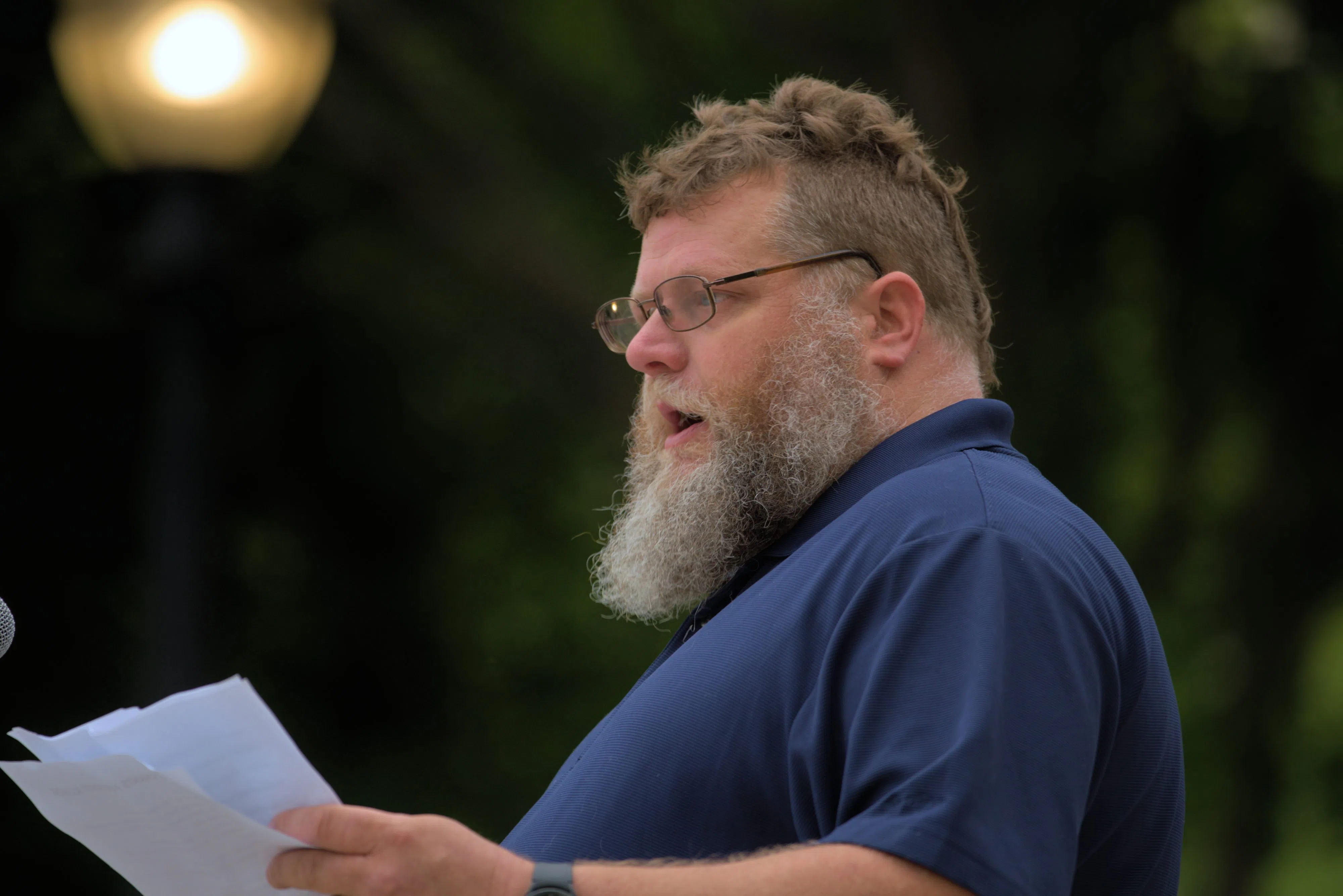
Aaron Cahill (WMAY News, Photo cred. Stan Anders)
“We must send a message,” Cahill told the alders, “clear and unapologetic, that Springfield will not be a pipeline for unjust detentions, deportations and racial profiling.”
For the most part, to date the calls at council have been met with silence. Frustrated, some public attendees at City Council speculate the city is hesitant to be seen responding to politically charged public pressure. There exists an understanding that doing so invites retaliation from a highly reactionary federal government. However, the argument for this admittedly redundant policy is that not only would such an ordinance cover the city in the event that something should happen to the Illinois TRUST Act; making such a change in city code would be a statement, helping to normalize criticism of ICE conduct by city governments which are impacted by the seizures.
If many cities are openly condemning ICE, proponents argue, retaliation by the federal government is made more difficult.
“It takes all of us to create an equitable society. Start by showing up for your community,” Maribel Cruz-Hine urged the City of Springfield. “Mahmoud Khalil has been detained for approximately ninety days. Don’t forget about him, and don’t forget about the other people being detained by ICE. Immigrants are not your enemy – they are people like you and me. We bleed the same.”
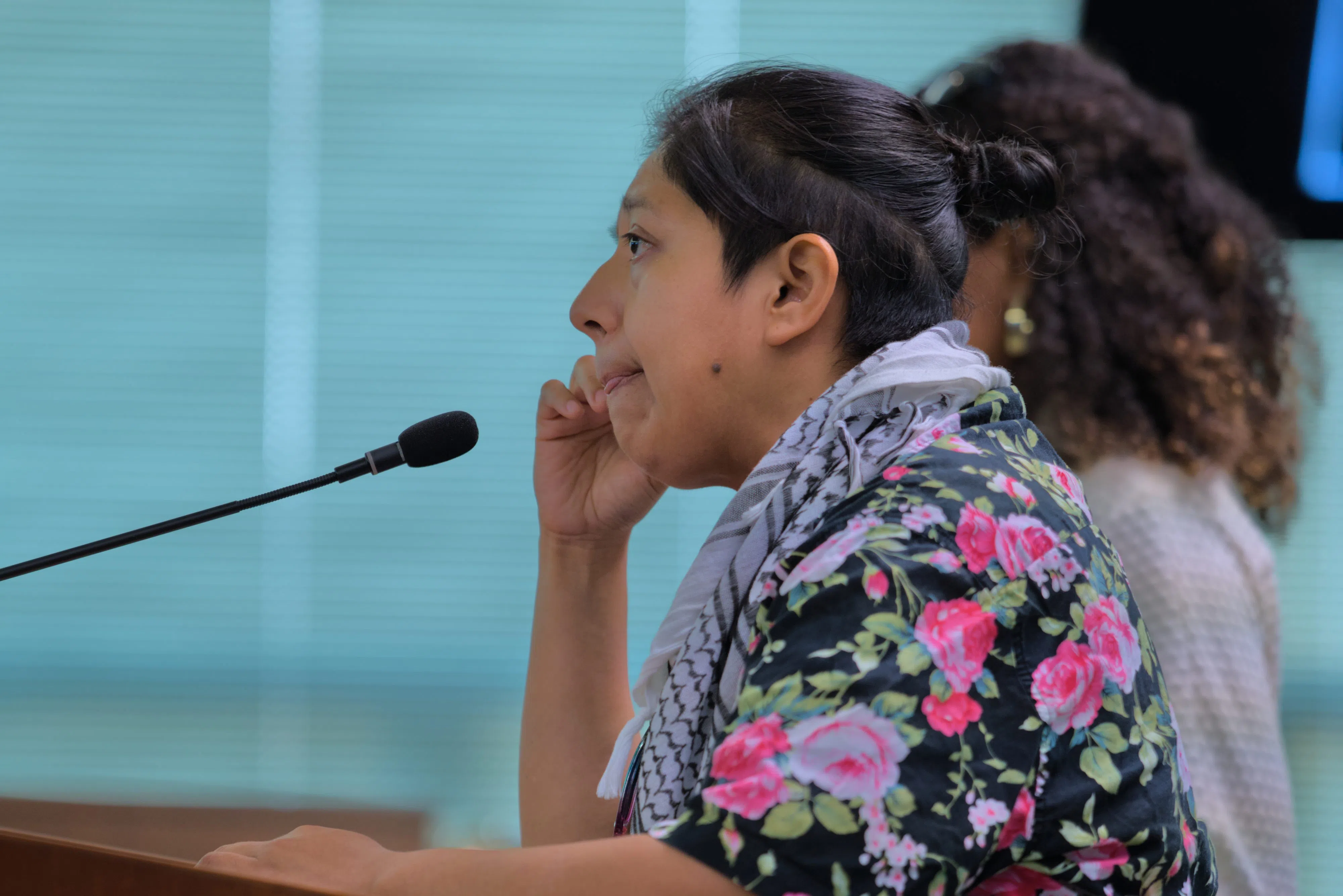
Maribel Cruz-Hine (WMAY News, photo cred. Stan Anders)


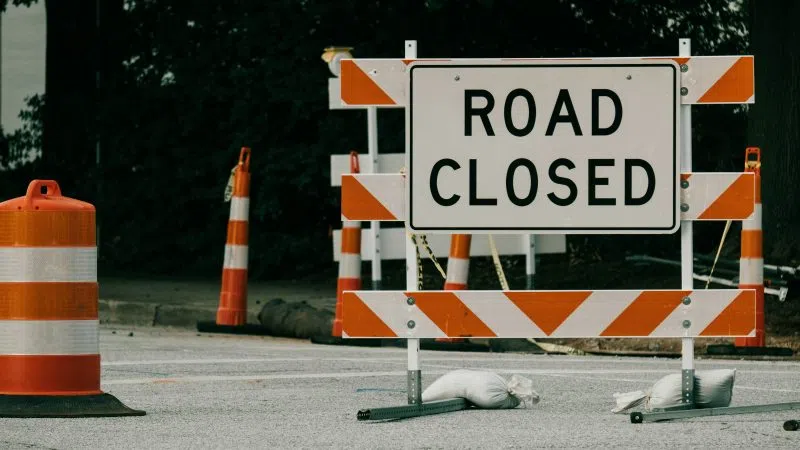




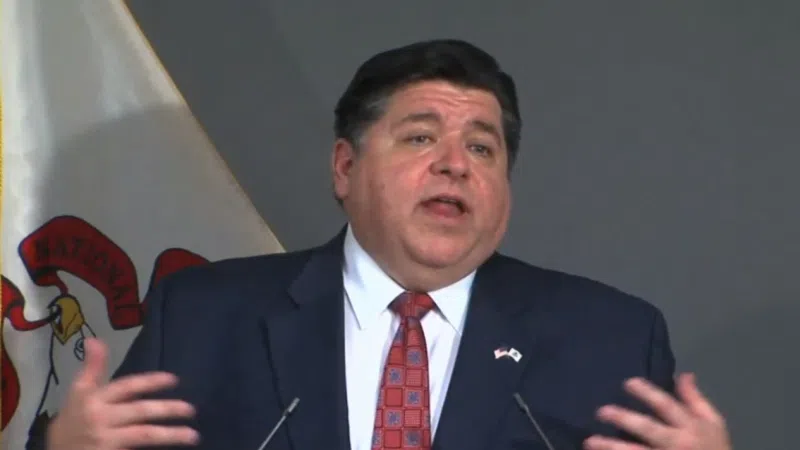
Comments